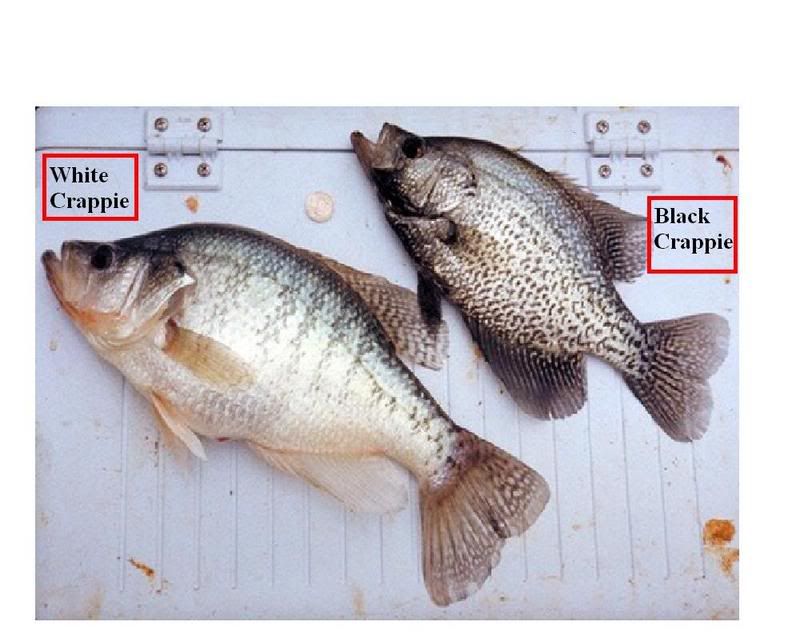It is not as easy as most think. Studies found that even trained FS often made the wrong call based on morphological features. I will find the info again. The standard answer is to count the spines 6 or less = WC , more than 6 = BC.

See if this is enough.
North American Journal of Fisheries Management
Article: pp. 121–125 | Abstract | PDF (426K)
Failure of Quantitative Phenotypic Characteristics to Distinguish Black Crappie, White Crappie, and Their First-Generation Hybrid
STEPHEN M. SMITH, MICHAEL J. MACEINA, VINCENT H. TRAVNICHEK, and REX A. DUNHAM
Historically, identification of fish species relied
on morphological and meristic characteristics,
which made it difficult to correctly identify hybrids
(Hubbs 1955). As knowledge of fish genetics and
breeding increased, researchers propagated crosses
between species and compared the meristic and
morphological characteristics of known hybrids to
suspected hybrids in natural populations (Hubbs
1955: Smitherman and Hester 1962; West and Hester
1966: Birdsong and Yerger 1967; Childers
1967). With the advent of electrophoretic techniques
and description of species-specific allo-
/ymes, recognition of hybrids between species has
become more accurate and can be achieved with
minimal effort (Ferguson 1980).
Common taxonomic keys indicate that the black
crappie Pomoxis nigromaculatus possesses seven
or more dorsal spines and that the distance from
the eye to the origin of the dorsal fin (nape length)
is about equal to the length of the dorsal fin base
(Smith-Vaniz 1968: Clay 1975: Eddy and Underbill
1978; Lee et al. 1980: Trautman 1981). The
white crappie P. annularis expresses six or fewer
dorsal spines and the nape length is much longer
than the length of the dorsal fin base. However,
black crappie, while crappie. and their hybrids
have overlapping morphological characteristics
(Buck and Hooe 1986; Dunham et al. 1994), which
makes it difficult to identify the parentals and their
hybrids in the field.
Discussion
In Weiss Lake, the characteristics examined
could not unequivocally distinguish among black
crappies, white crappies. and the F| hybrids. The
F| hybrids were more likely to be correctly identified
by an alternate combination of nape length
and dorsal spine count. However, 131 of the 474
(28%) crappies that were collected displayed alternate
characteristics and were not Fj hybrid crappies.
Buck and Hooe (1986) reported difficulty
identifying hybrids using phenotypic characters
and concluded that electrophoresis was the most
reliable technique to differentiate between the parentals
and reciprocal hybrids. These authors stated
that F| hybrids were similar in appearance to
black crappies. However, our results in Weiss Lake
showed that only 19% of the Fj hybrids expressed
both phenotypic measures characteristic of black
crappie. Eighty-five percent of the Fj hybrids in
Weiss Lake possessed seven or more dorsal spines.
This is similar to the results of Buck and Hooe in
which 91-92% of the F\ hybrids expressed seven
dorsal spines.
In addition, phenotypic measurements were not
discriminate for either parent. For both parentals,
there was a 43% chance of misidentifying crappies
by means of dorsal spine counts and nape measurements
at Weiss Lake (33% chance of misidentifying
a black crappie and a 10% chance of misidentifying
a white crappie with the two
characteristics).
North American Journal of Fisheries Management 8:123-126. 1988
© Copyright by the American Fisheries Society 1988
Allozymic Differences between Black and White Crappies
MICHAEL J. MACEiNA
IRA F. GREENBAUM
Additionally, first-year
growth of F, hybrid crappies can be greater than
that of either parental species (Buck and Hooe
1986). The use of meristic characters and color
patterns to distinguish F, crappie hybrids from the
parental species, however, is less accurate than
electrophoretic analysis (Metcalf et al. 1972; Buck
and Hooe 1986). Accurate identification of hybrid
and backcross individuals is essential for evaluations
of survival, growth, reproductive success, and
the success of any hybrid crappie stocking program.
Using meristic and color characters for the separation
of F, and parental crappies from each of
two populations, Buck and Hooe (1986) correctly
identified 65 and 96% of the individuals. These
authors reported that pigmentation and meristic
differences between hybrids and parental fish were
subtle and difficult to describe. Correct identification
of F2 or later-generation crappies by these
characteristics would undoubtedly be even less
likely.
http://www.pondboss.com/forums/ubbthread...true#Post118896